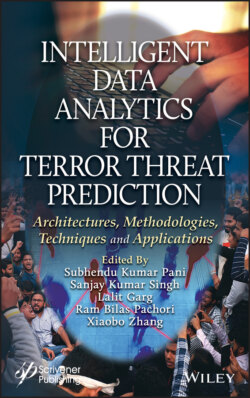Читать книгу Intelligent Data Analytics for Terror Threat Prediction - Группа авторов - Страница 54
1.7 Conclusion
ОглавлениеSocial networks like Facebook, Twitter, and WhatsApp are generating huge amount of data from their user profiles. But generation of huge data creates real world problems like rumor diffusion in network. It is difficult to find that whether information spreading in network is rumor or not and as each network has many users, it is not possible to find who spread that rumor. So classification of rumors and facts and finding rumor source in network is an emerging challenge in society. This chapter surveys various social networks, their features, cyber-crime and its classifications, and how these cyber-crimes occur in social networks. This chapter is specifically purposeful on cyber-crime in social network i.e. rumor diffusion. There are some popular classification algorithms such as Naïve Bayes and support vector machine classifiers to distinguish between rumors and facts. Next, to find source of a rumor consider three factors such as network structure, diffusion models, and centrality measures. There are two kinds of sources: 1) single source and 2) multiple source. To find single source use three approaches such as anti-rumor-based, query-based, and network observation. For multiple sources of rumor use several approaches like approximation-based, ranking-based, network partitioning, and community-based. These approaches improve probability of rumor detection and its source identification in social networks. However, there are many classification techniques and still some are not easy to use in finding based on existing features. So there is a need to consider more features and much better classification techniques. In rumor source detection, current research mostly focused on single source identification. But nowadays, multiple users are spreading rumors for fast dissemination over the social networks. Thus, there is need of developing new techniques to detect multiple sources of rumor.
